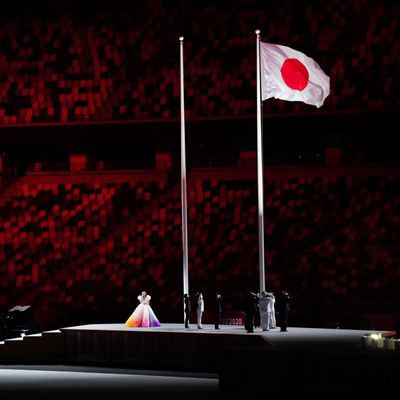
On Friday morning, the Tokyo Olympics kicked off with an opening ceremony that felt like an indictment of the Games as a whole. After a prerecorded video montage — something that already felt oddly out of place — the ceremony started with a single person running on a treadmill in a near-empty stadium. It was bleak, to say the least.
Part of the excitement of the Olympics is having so many people in one place, something that isn’t possible this summer. After postponing the events for a year due to the pandemic — hence why they’re still being branded as the 2020 Tokyo Olympics — officials have been hell-bent on making the Games happen despite pleas from public-health experts, a growing number of athletes testing positive for COVID-19, and [gestures wildly to an empty stadium] all of this. Earlier this month, officials announced that no fans would be allowed at the Olympics as Tokyo was under a COVID-19-related state of emergency. On Friday, Tokyo’s National Stadium, which can hold 68,000 people, had just a tiny fraction of its seats filled.
Also notably missing from the opening ceremony: many of the athletes. Olympic-sanctioned pandemic precautions are in large part responsible for these athletes’ absence, as they can only arrive in Japan five days before their event, meaning some competitors haven’t arrived in the country yet. As the New York Times noted, Canada has 370 athletes competing in the Tokyo Games, but only 30 or 40 marched in the ceremony. Simone Biles and the U.S. women’s gymnastics team were also not in attendance, with a spokesperson saying they were “focused on preparation.” Soccer player Alex Morgan tweeted that she and the rest of the U.S. women’s soccer team would be “parading around the hotel in our opening ceremony outfits” and preparing for their second game rather than participating in the opening ceremony.
Adding to the dystopian atmosphere, you could hear the voices of hundreds of protestors outside of the stadium during quieter moments of the opening ceremony. Leading up to today’s events, the Japanese public has been vocal about their opposition to the Games, with 83 percent of those polled in a May survey saying they did not want the Olympics to take place. By June, 10,000 of the event’s 80,000 volunteers had quit.
While the Olympics are usually cause for international celebration, this year’s events feel decidedly less so — and not just because of the pandemic. From the IOC’s opposition to protests to early favorite Sha’Carri Richardson’s ban from Team USA, the Olympics have come to seem less like a leisurely escape and more like another grim symbol of the state of the world. Throughout the opening ceremony, thousands of empty seats loomed in the background — a visceral reminder that maybe this year’s Games shouldn’t be happening at all.

